Feed aggregator
Grovel Reports Dec 27th 2021 - New Furry Convention Dates + More News

Hi everyone! Its close to the end of 2021 and there's plenty of 2022 news posted recently so here are the highlights: New Years Furry Ball https://www.newyearsfurryball.com/ PDFC https://painteddesertfc.com/ StratosFur will open Dealer Applications on Feb 10th 2022 https://twitter.com/StratosFur/status/1470823425862258692?s=20 Keep Tahoe Furry https://twitter.com/KeepTahoeFurry The Three Other Furry Conventions in CA https://twitter.com/furcon https://twitter.com/pacanthro https://twitter.com/GSFurCon FurSquared returns April 14-17th 2022 https://twitter.com/FurSquared/status/1471319150945615879?s=20 Japan Meeting Of Furries Returns Jan 8-9 2022 https://vr.jmof.jp/en/ Fur-Eh! Returns July 14-17th 2022 https://www.fureh.ca/ Confuzlled will open Registration Dec 29th 7pm UK Time. https://twitter.com/cfconvention/status/1475487946417614852?s=20 If you like the work I do please like/follow/share to support the channel I'm on multiple platforms https://twitter.com/GrovelHusky https://www.twitch.tv/grovelhusky https://t.me/grovelreports Subscribe to show support https://www.youtube.com/c/GrovelHusky/?sub_confirmation=1 Grovel Reports Studio made by Kydek https://twitter.com/FluffyKydek Banners used in the channel were made by Slushi https://twitter.com/Slushi3Brushi3?s=09 Music created for Grovel Husky by Whooshagg https://whooshagg.com/ Grovel Reports Dec 27th 2021 - New Furry Convention Dates + More News #Stratosfur #Confuzlled #KeepTahoeFurry
Bearly Furcasting S2E35 -Merry Christmas Every Fur!
MOOBARKFLUFF! Click here to send us a comment or message about the show!
Moobarkfluff! Bearly and Taebyn chat on this Christmas Morning podcast about Christmas, Sardines, and have lot's of bad puns. We read a story that is a response to the 12 days of Christmas. Taebyn regales us with his 12 Days of Pupmus. We even make a phone call to the Jolly ol' Elf; Santa! Who doesn't have a tree? Taebyn. He has a Christmas Fig! Christmas will never be the same again. Moobarkfluff!
Do You Like My Decorations? Link below
BFFT Merch (Murch)
https://www.bonfire.com/store/bearly-furcasting/
Thanks to all our listeners and to our staff: Bearly Normal, Rayne Raccoon, Taebyn, Cheetaro, TickTock, and Ziggy the Meme Weasel.
You can send us a message on Telegram at BFFT Chat, or via email at: bearlyfurcasting@gmail.com
Lets Explore Anthro NorthWest's 2020 VR World

Hi everyone! AnthroNW will have a VR event on Dec 26th 2021 which means the current world will be replaced with their new one. This world is on SDK2 and the new one will be on SDK3. With only a few days left I wanted to make sure I could show the world before its no longer accessible in its current state. Main Website: https://www.anthronw.com/ Here is a link to the world if you want to check it out. https://vrchat.com/home/launch?worldId=wrld_7d7594a6-7de2-43d3-b927-16f222a2a656 Is there a world you would like Grovel to explore? Please let me know cause I love seeing what is out there in the VR world. If you like the work I do please like/follow/share to support the channel I'm on multiple platforms https://twitter.com/GrovelHusky https://www.twitch.tv/grovelhusky https://t.me/grovelreports Subscribe to show support https://www.youtube.com/c/GrovelHusky/?sub_confirmation=1 Lets Explore Anthro NorthWest's 2020 VR World #AnthroNW #AnthroNorthWest #ANW2020
Suspected COVID-19 close contact at Fur-Eh! event tested negative

Canadian convention Fur-Eh! said Monday (Dec 20), a possible COVID-19 close contact attended their Christmas in-person event. They say the attendee had “some symptoms” of COVID. Fur-Eh! adds, the attendee may have a breakthrough COVID case in their family. A “breakthrough” case means someone who got COVID-19 after taking the vaccine. The attendee tested for […]
TigerTails Radio Season 13 Episode 43

TigerTails Radio Season 13 Episode 43. Join the Discord Chat: https://discord.gg/SQ5QuRf For a full preview of events and for previous episodes, please visit http://www.tigertailsradio.co.uk. See website for full breakdown of song credits, which is usually updated shortly after the show.
S9 Episode 14 – Conrunning
Klik and Firebreath talk about con running with Aeden and Scani!
NOW LISTEN!
SHOW NOTES SPECIAL THANKS- Aeden, our guest
- Scani, our guest
The following people have decided this month’s Fur What It’s Worth is worth actual cash! THANK YOU!
Uber Supporters
Sly
Premium Tier Supporters

Jarle, the Spirit Wolf
Get Stickered Tier Supporters

 Nuka goes here
Nuka goes here 

Kit, Jake Fox, Nuka (Picture Pending), Ichi Okami
Fancy Supporter Tier
![]()
![]()

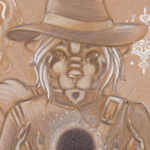


Rifka, the San Francisco Treat and Baldrik and Adilor and Luno
Deluxe Supporters Tier
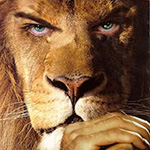



Guardian Lion and Koru Colt (Yes, him), Ashton Sergal, Harlan Fox
Plus Tier Supporters
- Skylos
- Snares
- Simone Parker
- Ausi Kat
- Chaphogriff
- Lygris
- Tomori Boba
- Bubblewhip
- GW
- Moss
McRib Tier Supporters
- August Otter
MUSIC
- Opening Theme: RetroSpecter – Cloud Fields (RetroSpecter Mix). USA: Unpublished, 2018. ©2011-2018 Fur What It’s Worth. Based on Fredrik Miller – Cloud Fields (Century Mix). USA: Bandcamp, 2011. ©2011 Fur What It’s Worth. (Buy a copy here – support your fellow furs!)
- First Break: Heaven and Hell – Jeremy Blake, Creative Commons, 2018.
- Second Break: Mystery Skulls – Ghost. USA: Warner Bros Records, 2011. Used with permission.
- Third Break: Light (Remix), Argofox, Creative Commons 2019.
- Closing Theme: RetroSpecter – Cloud Fields (RetroSpecter Chill Mix). USA: Unpublished, 2018. ©2011-2018 Fur What It’s Worth. Based on Fredrik Miller – Cloud Fields (Chill Out Mix). USA: Bandcamp, 2011. ©2011 Fur What It’s Worth. (Buy a copy here – support your fellow furs!)
Bearly Furcasting S2E34 - Furries in the News, Storytime, Jokes
MOOBARKFLUFF! Click here to send us a comment or message about the show!
Moobarkfluff! Bearly and Taebyn chat about lots of things, we read a story: Super Torta. Just how badly can we massacre a language? After all that we tell some really bad jokes. It's not a long episode, but it's a good one! Join us, won't you, on this furtacular adventure into the unknown! Moobarkfluff!
https://www.bonfire.com/store/bearly-furcasting/
Thanks to all our listeners and to our staff: Bearly Normal, Rayne Raccoon, Taebyn, Cheetaro, TickTock, and Ziggy the Meme Weasel.
You can send us a message on Telegram at BFFT Chat, or via email at: bearlyfurcasting@gmail.com
Get Healthier by Taking Small Steps
Hello. I have a question regarding physical and mental health. Lately, I have been unhappy with my body, and I always tell myself, “I will get into shape when I get home!” But when I get home, I just give up. I just feel so … defeated right now. Do you happen to have a strategy to keep your mind focused on exercise, and how to keep a positive self image?
Cooper the Moth
* * *
Dear Cooper,
Thank you for your great question. This is a problem that many people — furry and non-furry alike — struggle with. Do I assume correctly the problem is that you feel you are overweight and that when you say "mental health" you simply mean getting in the right frame of mind to get in shape? It's really not a mental health issue, unless you're having a problem with self-esteem?
Let's start with basics. Our worries about how our bodies look are largely dependent on what we feel others think of us and what society dictates is the ideal body type. It also has to do with health, of course. So, the first question is, "Why do you wish to lose weight? Is it because people are body shaming you, or is it because you don't feel well and want to be healthier?" I know people who are perfectly thin, yet they tell me all the time that they are fat and feel like slobs. This is the result of family, peers, colleagues, and TV commercials shaming them. We also blame people for being overweight, but the food and restaurant industries in the USA conspire to fill us with fat and sugar. Most Americans also work at sedentary jobs, then they drive home and sit in front of the TV all night. This is all encouraged by our current society, which then blames YOU for being overweight. Doctors are often part of the problem when they insist on us adhering to the BMI (Body Mass Index) recommendations, which are often absurd and inaccurate. BMI standards vary from country to country and cannot measure the difference between fat and muscle weight.
The first step, then, toward having a positive body image is to ignore outside opinions of what your body should look like. Your first priority is to be healthy. That doesn't necessarily mean weighing 90 pounds. You can be beefy and healthy. Have you seen the men who are in those strongest men competitions? If you took their BMI measurements, it would say they were fat!
Okay, so you throw away outside opinion and just work on being healthy. Step one is to see your doctor and assess your current health. I have no idea if you have any medical conditions, but things like having a bad back or diabetes or circulation problems can and should influence your course of action in getting in shape.
Next, assess your dietary needs. If you're eating a lot of junk food and McDonald's, you need to quit that right now. Also, don't drink soda and don't eat processed foods. Eat fresh foods whenever possible. Just doing this will have an amazingly positive effect on your weight and health.
Finally, start an exercise regimen that suits your needs. You don't have to work out at a gym 12 hours a day and run marathons to be in shape. Start slow. Exercise just 10-15 minutes a day. EVERYone has at least 10 minutes to fit in some exercise. And exercise can include many things. Take a walk (walking a mile burns fat just as much as running a mile), ride a bike, play some basketball. Just get active. As long as you're moving, you're doing your body some good. Find a sport or other activity you enjoy and exercise will be fun and not seem like work at all. Remember, small. This will prevent you from feeling overwhelmed. I imagine that when you say you're going to go home and get in shape that you are thinking something like, "I'm going to go home and lift weights for an hour." Then, you get home and that goal just seems really intimidating and, let's face it, exhausting, so you go to the pantry and grab a sleeve of Pringles and watch TV instead. Inertia is a bitch.
So, there are my three pieces of advice: 1) stop listening to outside critics; 2) eat fresh foods; and 3) get active by doing fun stuff and/or taking small steps toward getting more active.
Hope that helps!
Hugs,
Papabear
Furry finishes record-breaking spaceflight on the Blue Origin

中文:福瑞在蓝色起源号上完成破纪录的航天飞行
Convention updates 16/12/21

FurUM 2021 on VR Starting off from Southeast Asia. First, to Malaysia. Local convention Furs Upon Malaysia, or FurUM, published their 2021 events timetable. They will hold this event, called FVRUM, on the social gaming platform VRChat. Their venue is a recreation of their real-life venue, Armada Hotel. There will be panels and dance sessions […]
Tempo Talks with Sarah Granke (Birds & Bees, Nova Scotia)

Tempo talks with Sarah Granke, a sexual health educator, equal-rights activist, and policy-maker in the province of Nova Scotia, Canada. She led a team that created the two-part animated short film "Sexual Violence with the Birds and the Bees." The videos feature anthro birds and bees navigating common situations and present realistic options helping promote consent. "Sexual Violence with the Birds and the Bees" https://www.youtube.com/watch?v=87lUoaGhUbU https://www.youtube.com/watch?v=ilglSpeqpx8 Special thanks to Dralen Dragonfox for audio editing assistance! Art: Slate Dragon https://furaffinity.net/user/slate Merch, Sweet Tees and stuff: https://culturally-fd-merchandise.creator-spring.com/ Support Culturally F'd: https://www.patreon.com/culturallyfd Listen in on TEMPO TALKS with Tempe O'Kun https://www.youtube.com/playlist?list=PLIPk-itLl1jPyIK2c7mK-LpbvfDNqfcSW Check out Tempe O'Kun's books "Sixes Wild" and "Windfall" here: http://furplanet.com/shop/?affillink=YOUTU2907 Here's a playlist of his other Culturally F'd videos: https://www.youtube.com/playlist?list=PLIPk-itLl1jPS7tnT4hdJwBI-CeLF8Kb_
GFTV unifies English and Chinese podcast news channels
Issue 13

Welcome to Issue 13 of Zooscape!
A new day is dawning for furry fiction.
Science-fiction was once a looked-down-upon genre, small and shoved off to the side, kept away from serious literature, back at the turn of the previous century. Now, it’s a booming field, filling the airwaves with blockbusters.
Well, furry fiction already has blockbusters. Now it’s time to start labeling them. If it’s about talking animals, it’s furry. If it’s about talking dragons or gryphons or unicorns, it’s furry. There is furry fiction mixed up all throughout the other speculative fiction genres, and readers who want to find it are ready to see it labeled properly under a name that lets them find it.
This will be the century when furry fiction rises up, and we’re here to be a part of that.
We’re here to raise up furry fiction.
* * *
Rabbitheart by Archita Mittra
Scale Baby by M. H. Ayinde
To Gentle the Wind by Deborah L. Davitt
A Star Without Shine by Naomi Kritzer
Be Productive Like Cha-Cha by Katlina Sommerberg
The Incandescence of Her Simulacrum by Logan Thrasher Collins
A Chance to Breathe by Daniel Ausema
* * *
As always, if you want to support Zooscape, check out our Patreon. Also, please consider us and our stories when you’re making nominations and voting for awards in the coming year.
NOTE: if you’re curious about what awards eligible work we published last year, check out our brand new Awards Eligibility Post.
A Chance to Breathe
by Daniel Ausema
 “…the beaked natives ambled over to inspect the immigrants and welcome those allowed to stay. Tirket calmed her breathing. Don’t let her cough now.”
“…the beaked natives ambled over to inspect the immigrants and welcome those allowed to stay. Tirket calmed her breathing. Don’t let her cough now.”
The passenger ship floated down to land, and Tirket wasn’t the only one to cough and wheeze. Her carapace ached as it stretched with each heaving breath. The weeks in the hold hadn’t been a kindness to any of them. She pushed toward the nearest window, longing to see the city — the songbird city with its fabled machine-craft. The doctors promised she might breathe easier there in the dry air. In her mind it was a wide land of bulbous buildings and sprawling parks, bronze and green. Of fresh air that welcomed the fluttering of her wings, air that tasted of flowers.
The windows, though, were rimed in salt too thick to see through clearly, and the sailors wouldn’t let them above until the airship was secure.
Tirket circled her antennae impatiently and focused on breathing. A tang of oil set her to coughing again.
At last the doors opened. Treated bamboo framed the towering buildings beside the airship, and the beaked natives ambled over to inspect the immigrants and welcome those allowed to stay. Tirket calmed her breathing. Don’t let her cough now. Let her seem as healthy as anyone could be after such a journey over the ocean. The engines of the airship hissed above her head.
While she fell in line with the other immigrants, a troop of humans ran past, each the height of one of her leg segments. They chattered high-pitched instructions and unloaded the airship’s luggage.
“What are your skills, beetle?”
Tirket had been so absorbed in how she would convince the bird doctors of her health that she didn’t understand the question at first. The words made sense, even coming from a beak. She’d spent months before boarding the airship learning the native language. But they didn’t form a complete thought.
“My skills? Oh.” Stifle that cough. “I’m quick with my legs.” She waved two pairs in front of the bird. With their impractical wings, the birds always needed such help, though Tirket knew she wouldn’t survive factory work on her lungs. She only needed to get through, then she could find a way to the frontier where they didn’t care what kind of lungs you had. They can’t ask about my health. Don’t let them. The air here was dry, and that felt good, but smoke and oil trickled into her lungs.
“You fly too?” The bird gestured with a wing at her back.
Tirket flexed, and they shuddered, but she shook her head. “Only slow myself from falling.”
Without a question about her health, without any exam at all, the bird waved her on to one doorway that already had its own line of immigrants. Beetles, as the natives called them. Tirket had learned the word early in her studies, a derisive term, but she wouldn’t let it bother her. As long as they let her in. Through this door, past the bamboo wall… she pictured arrows on the ground to direct her beyond the city to clustered sacs of promised fresh air. Lungs become geography.
“It will be a long wait.” A crested bird paced beside the line, trailed by a troop of humans, their arms for the moment empty. Tirket thought he might be some kind of woodpecker. “They’ll be sending you to your assigned jobs, and you’ll likely be late for dinner. If hunger takes you, though…” The bird swept a wing back.
Where? He seemed to indicate the airship behind them. Or maybe the open flag where the ship rested for unloading and maintenance. “Take any you want. They are quite tasty. I will be the one you pay, and we ask only that you not snatch one who is carrying gear at the moment.”
The humans. The bird was offering the slaves for their snacks. Tirket’s stomach clenched, and she looked away. Hunger did grow, though, as the line crept forward. The first time a passing bird grabbed a human, everyone in line cringed and turned away. As evening came, several of the immigrants pooled some money and shared one amongst themselves. She’d come with some money, knowing she couldn’t expect to earn much through work, but even as the others in line gave in to hunger, she wasn’t tempted. Eyes closed, she focused on the dry air.
Her breaths wheezed by the time she came to the front. She scarcely listened as the robin within explained where she’d work the next day, what she’d have to do with the massive steam engines, what would be expected. She only listened to where she’d have to go. The sky, when she emerged, was dark, the cooler air a relief to her lungs. She enjoyed it only briefly before she was led into a brick-and-bamboo building, a dark shape that blocked most of the remaining light, and shown to her bed.
* * *
Tirket couldn’t work in the morning. Her breath was strangled by oily smoke and exhaustion. Some leeway seemed allowed to those just off the boat, because the others didn’t try to push her out when the steam whistles blew. She lay in bed and imagined snow on the ground, dry mountain air.
At mid-morning, at last, she pulled herself upright and clambered to the wall at the end of the room, leaning against bunks as she went. A window, tall and narrow, gave a view of neighboring roofs below them. The city stretched farther than she’d imagined. As far as the hazy air obscured the horizon she could see buildings, not bulbous as she’d pictured, but showing the distinctive bamboo frames filled with red bricks. Smoke or steam rose from nearly all the buildings.
Streets cut between them, in places drawn ruler-straight — probably where a fire had razed earlier factories — and in others tight-twisted and narrow. Steam cars cruised along the streets, many open to the smoggy air. Not once did Tirket see one of her insect-like people in those cars. Only the native birds rode, unless perhaps the closed-roof cars hid beetle riders. Tiny humans darted about the streets or rode in caged trailers behind the cars. She looked at the sky for airships, but the window faced away from the airfield.
As she pulled herself back along the bunks, high-pitched laughter echoed off the walls, and two humans raced in, playing some sort of game.
“Oh.” One pulled up short and stared at her. The other stepped away from the first and echoed her… or him, Tirket couldn’t tell with humans. Tirket waved a leg to tell them not to worry, but her lungs wouldn’t let her speak.
“We’re just… we’re here to clean.”
Tirket coughed, still trying to wave them on and move herself toward her bed. It was too much at once, and the humans rushed over to support her. In bed she closed her eyes and wheezed. As her lungs found the air to calm her, she realized her hunger. What had she eaten since leaving the airship? Nothing. Without thought, she said aloud, “I’m hungry.”
There was noise around her, but she couldn’t identify it. It didn’t sound like cleaning. When she opened her eyes, both humans knelt beside her bed, trembling, their heads bowed. “You may choose,” one said in a pinched voice.
Tirket couldn’t even bring any of her legs up to push the idea away. “No, I…” The words had no force to them, no breath to give them sound. “Food. Bring me. Whatever. From the kitchen.” Her eyes closed, and she heard human voices that never resolved into words.
She woke to a steam whistle. A tray of food lay beside her bed, and she hurriedly ate it before the workers returned. It was a tasteless mush but filled her stomach pleasantly. She fell back asleep before the others came in.
* * *
The next morning brought her some questioning looks, but still no one forced her from the room or asked after her health. The same humans came early in the morning with another tray of food. “What are your names?” Their eyes widened, and they backed away without answering. If they cleaned the room again, it must have been while she slept.
They returned in the afternoon and stood beside her bed, shifting their feet.
“I’m Rae,” one said. Or Ray, maybe. “And I’m Tay.” Both had long hair and features that looked the same to her. One — Rae, she thought — had darker skin than the other.
“Thank you, both.” With one leg she pointed at where the tray had been —gone now, she noticed. Her lungs labored on the city air. “Might you know of anywhere I could sleep with an open window?”
Tay cocked his (her?) head. “Why?”
Tirket coughed. “The cool, night air. It’s… I can breathe it better.”
Rae shook her (his?) head. “No windows.”
“Maybe the roof, though.”
“Maybe,” the other one echoed.
They left without saying anything else, and Tirket fell asleep. She woke in the night to movement. The sounds of sleepers filled the room, but that hadn’t woken her. She’d been moved. She lay in a smaller bed, one that had no upper bunk. Some fifteen or so humans surrounded her, carrying the bed out of the room. She propped herself up, but Tay or Rae leaned in and signaled for silence. She lay her head down and let them carry her up steps and onto the flat roof. They buried her in a mound of blankets, and she breathed the cool air until she slept.
* * *
During the days that followed, Tirket came down to the main dormitory. The other workers would already be gone and the sun beginning to heat the city air. She slept, despite the hours she’d slept in the night on the roof, and dreamed of how she might escape the city. Tay and Rae brought her food and even talked with her about their work, the building, the songbird natives. After several days she broached the subject of leaving the city.
“I can’t catch my breath here. The doctors in the old country prescribed clean air and promised it to me here.”
“Beyond the city?” The idea confounded them. Some of the humans there had traveled within the city, they explained, but Rae and Tay had been born in that building and always lived there, working, afraid of hungry birds and beetles. They agreed to find out what they could.
“You have money?” they asked her the next day. “You can ride in a cab, if you can pay.”
“I have some.” More than most immigrants to be honest. Most came because they had little to begin with, desperate for work and the chance to make their own fortune. She’d come not wealthy but comfortable, with her family’s blessing. “Can you summon the cab for me?”
They supported her down to the street that afternoon. The cabbie stepped from his car and stared at them, humans and a beetle, snacks and dumb labor. She saw the thought in his eyes.
“I want you to take me to the edge of the city.”
“Can’t, miss.” The cabbie was already returning to his seat. “This is a city cab, for birds only. You’ll have to find a bus or walk.” The last words were deadened by the shut door, and the cab pulled away.
“A bus?” Tirket looked at the milling group of humans. How terrible to be outside like this where any passing person might choose them for food. She led them inside and stopped at the base of the stairs. Cracked tiles threw off her balance, and the stuffy air forced her to sit, to breathe as deeply as she could.
One human squeaked a reply. “No buses. Not this time of year. They mainly run in the winter.”
They trickled away until only Rae and Tay were left. “I can’t walk, can I? It’s too far.”
Damn her lungs. Damn the consumption that made them weak! She let them walk on each side of her, up the narrow steps straight to the roof. The day air was no easier on her lungs than inside, and the light made it harder to sleep, but it didn’t matter, nothing mattered. Might as well languish in the bedclothes, become a symbol, a woman for someone to love selflessly — or at least tell himself that, because her imminent death meant his love would never be tested. Such was the fate of those with her illness back home.
Her tossing dreams showed her the buildings of the city, but transformed. Bamboo formed the walls, but not dried and reinforced. Entire buildings waved in a smoky wind, as bamboo stalks will in the wild. But there was nothing of the wild in the image, despite that resemblance. Everything seemed constructed, even the glaring sunshine where it broke through the smog.
Great engines swallowed their workers. Brass craftsmen — all of them native birds — marched in step to showcase their wares. Shifts of factory workers shuffled in unison to the beat of a deep whistle. And there she was, above the throngs, encased in her bed on top of a swaying building. She saw herself from outside, face and blankets alike turned to an icy slate. A line of beetles climbed ever toward her, intent on worshiping her still form, but each time one reached the roof, human hands dragged him up and tossed him down the other side.
Tirket sat up, awake beneath cold stars. The dream images faded slowly as her lungs gulped air. She wouldn’t let it happen. Despair was not in her, not for one who had crossed the seas and skies in a cramped airship for this chance. Somewhere open land waited for her, land even she could work, because the air would be clean and dry. Somewhere a clearing in a high valley longed for a mud cabin to be built by her six legs.
If she had to crawl building by building, she would. Night by night, wrapped in blankets, her days she could spend wherever the night left her, tucked within an unlocked doorway, huddled on the street, maybe even on neighboring roofs, if she could find the way and the strength to climb. It might take a month, but she wouldn’t stay to become a symbol of empty fantasies.
The street was empty when she reached it, but the trip down had taken longer than she’d hoped. Her lungs couldn’t find the air, and she had to rest. At this rate it would take a month just to cross a block, a lifetime to reach the wilderness. A healthy lifetime, that is. If she had to stay in the city, Tirket’s lifetime would be much shorter.
Dawn neared, and the morning’s first cars whistled their ignition. Air whistled in and out of her lungs too, and she imagined them as steam engines, decrepit, failing. Clogged with the film left from inferior coal. She stumbled across the street, unable to look anywhere but straight ahead. Someone yelled at her, but why she didn’t know.
Along the building opposite, she kept her hand on the wall, pulling herself as well as she could. Smog gathered in her lungs, and the air warmed up. She collapsed in a recessed side door of the building. She didn’t think her breathing would let her sleep, but she did, curled against the unused door. Once a bird woke her, asking her business, but the look in her insect eyes must have been all the answer he needed.
When night came she struggled to her feet. The buildings swayed as they had in her dream, though she knew it was only her dizziness. She tried to focus ahead, to pick one spot and aim for it, but her head kept pulling down. Her goal became simply one more step, that next crack in the pavement, that bit of debris, the base of a street-lamp.
Tirket couldn’t guess how much of the night had passed —she hadn’t gone far, however much it was — when someone came up beside her. Rae, she thought, and Tay on the other side. Then a dozen more human hands grabbed her, eased her back onto a pile of blankets.
“What…” Was this some kind of betrayal with the humans bringing her back to their bird masters?
The blankets moved, a cot that the humans carried underneath her. Not to bring her back, but continuing along the street.
“Why…” She looked to either side at Rae and Tay and the other interchangeable humans carrying her. “There must be thousands of us every year. Beetles,” she gave the word all the derision that the birds used, “overrunning your city, preying on your people.”
Tay looked away from her as if the answer was embarrassing.
Rae answered though, dark face crinkling in an expression Tirket couldn’t interpret. “Maybe it’s because you didn’t. Didn’t prey on us, I mean. And others saw that you didn’t, saw you turn away in disgust throughout that first day. We asked around about you, and those people at the airstrip remembered.”
Maybe. Tirkit doubted that explained it all though. She imagined an underground movement among the humans, resistance groups that Rae and Tay stumbled on as they made their inquiries about getting her out of the city. She’d be a symbol for them. An image of overcoming the songbird city, of fighting even when it became difficult to continue. But much better to be a symbol for resistance than a symbol for empty romantic gestures.
The cot jolted and jerked as they walked, and Tirket had no answer. Engines still sounded, even in the night, and the streets were not fully empty. Her human carriers huddled against the bed but walked as confidently as they dared — her antennae tensed with their mingled fear and determination — and they made good time.
Tirket phased in and out of wakefulness, and it could have been dreams or simply waking imagination, but she saw how they must look from above. The bed floating along dark streets. Her own insect head propped on a pillow, the rest of her swallowed by heavy blankets —white and blue — that also hid most signs of the little humans carrying her. Only a careful observer would note their heads and pale clothing. They moved as fast as was reasonable, but the city dwarfed their strides, so the bed did not race but must seem instead something from a dream itself.
What stories might an insomniac tell in the morning of her night-time visions? A beetle goddess leaving the city? A lonely death parade for the nameless, dying workers? No one would believe it.
They would not reach the edge of the city that night, but that didn’t bother Tirket. The humans would find a place for her bed and sleep beneath it through the day, safe from hungry passersby and angry owners come to retrieve them. They would make it out of the city some night, and then beyond. When the air grew clear enough, she would walk, and with Tay and Rae and whichever of the rest wished, she could establish her homestead, them free of predators and her free to breathe air clean and dry.
For the moment, she lay back and breathed as well as she could, and the city of the songbirds floated by.
* * *
 About the Author
About the Author
Daniel Ausema’s fiction and poetry have appeared in many places, including Strange Horizons, Daily Science Fiction, and Diabolical Plots. His high fantasy trilogy The Arcist Chronicles is published by Guardbridge Books, and he is the creator of the steampunk-fantasy Spire City series, set in a world of beetle-drawn carriages and chained singers. He lives with his family in Colorado, at the foot of the Rockies.
The Incandescence of Her Simulacrum
by Logan Thrasher Collins
 “Eudaimonia used a pseudopodium to absorb the luminous spherule and store its data in the sponge’s biomolecular memoryspace.”
“Eudaimonia used a pseudopodium to absorb the luminous spherule and store its data in the sponge’s biomolecular memoryspace.”
Eudaimonia woke in wetspace, conscious yet missing bodily form. She could not see or hear, though her mind’s dynamical oscillations conjured phantasmagoric flashes of illusory blue and purple light. But this was to be expected. Eudaimonia’s brain had been stored on a biological computer under the flesh of a sea sponge. The sponge’s computational organ consisted of a dense pellet of cellular nanomachinery, packed chock full of ribonucleic memristors and multiplexers. After a few minutes of adjusting to the shock of the new cognitive vessel, Eudaimonia turned on the sponge’s senses. She had paid handsomely in squishcoin to spend a few hours in this sponge. Eudaimonia had an important purpose here. She was not about to waste her money.
As sensory nanofilaments fed into the sponge’s computational organ, a shock of light and texture burst into Eudaimonia’s awareness. She found herself partially submerged in a tidepool at the edge of a vast salty ocean. Though this planet was far from Earth, somewhere in the M4 globular star cluster, massive terraforming efforts had turned it into a fairly Earthlike world. But Eudaimonia did not care much about the details of this planet’s location or geobiology. Eudaimonia just wanted to know why Desdemona had left the starship Remora. Why Desdemona had left her behind.
It had taken months of cybertrawling to find Desdemona’s location. But Eudaimonia’s efforts had paid off. Casting in a space with a volume of thousands of light years, she had nailed down Desdemona’s coordinates to the cubic meter. Down to this very tide pool. In this day and age, no one could stay hidden forever.
Per Eudaimonia’s will, the sponge emitted a gush of inky quorumstuff. The juice contained nanites which would allow her to communicate with Desdemona through an exchange of electrochemical signals.
“Hey there darling.” The sponge had no ears, but its computational organ translated the electrochemistry into audio. Despite her misgivings, Eudaimonia felt a sense of warmth spreading through her sponge’s tactile network.
“Hello my love,” she replied. It had been a long time since they had first met at Discotheque de Kosmos. Memories of a peppermint-sweet first kiss flashed into Eudaimonia’s mind. As Eudaimonia reminisced, a spiky crab crept from a crevice in the slimy rocks. Eudaimonia could see Desdemona’s signature baroque style in the crab’s obsidian and golden pigmentation. When in human form, virtual or flesh, Desdemona had often worn dresses and tattoos with those colors.
“I know why you’re here,” Desdemona stated. “You want me to come back.”
“I want to know why you vanished,” Eudaimonia replied tremulously.
“You sought to explore the galaxy and achieve greatness through your art and your science. I got hooked on Voluptuous. I couldn’t let my addiction hold you back. You saw me using it. You should have known what would happen.”
Eudaimonia remembered opening a door aboard the Remora to see Desdemona jacked into a linkup, shivering with ecstasy. Eudaimonia had immediately ripped out the jack. At first, Desdemona had fought with violent screams. But she had eventually calmed and promised to cease doing Voluptuous. Eudaimonia had been eager to leave the nightmarish evening as far behind as possible.
“But that was just once. I thought you stopped after that.”
Desdemona laughed bitterly and the crab quivered. “I lied. I couldn’t stop. It felt too good. Better than anything else. Better than you.”
Eudaimonia gazed at the crab with shock and dismay. It hurt like getting stabbed in the kidney with a shard of obsidian.
“Look… I’m sorry. Voluptuous got me. It incorporated itself into my soulfile and I can’t get it out without dying. I wish so so very much that I could have stayed, but I couldn’t. It’s awful. I’m a fool who let you down. I used Voluptuous and now I’m stuck hiding in this pool, jacking myself into it again and over again.” Desdemona gestured with her claws at the hole in the rocks.
Of all the possibilities for why Desdemona had left, Eudaimonia had not expected this one. She had thought she herself had done something wrong. Some little mistake which would have made Desdemona hate her. It would have been better if Desdemona had hated her.
“When you leave… take this with you,” Desdemona exclaimed suddenly. The crab pulled an incandescent pearl from beneath its shell.
“What’s that for?” Eudaimonia asked dejectedly.
“Let’s call it a fresh start. It’s a backup copy of my soul from before Voluptuous. You have to understand though; it won’t remember anything that happened between then and now, and it won’t really be me. I’ll still be here in this tidepool, jacking myself into the machine until Voluptuous kills me.” Desdemona took a deep breath. “But the pearl contains all that remains of who I should’ve been.”
Eudaimonia felt the urge to cry, but the sponge had no nasolacrimal ducts. “Are you… are you sure this is the only way?”
“Darling, this isn’t all that bad.” The crab smiled sadly, to as much of a degree as a crab can smile sadly. “I know it hurts to let the first me go. But my memory will live on in the new me. You and she can build the life you’ve both wanted. I need you to do this.” The crab gently nudged the pearl towards the sponge. Eudaimonia used a pseudopodium to absorb the luminous spherule and store its data in the sponge’s biomolecular memoryspace.
“So, this is goodbye I suppose.” Eudaimonia stated quietly.
“Perhaps in some ways my darling.”
“I love you.” Eudaimonia said.
“She will love you till the stars burn out.” Desdemona promised.
Eudaimonia willed the sponge to beam her mind back to the Remora, carrying the precious cargo of Desdemona’s new soul. Eudaimonia felt her consciousness reload into a human body aboard the Remora. She opened the palm of her hand to see the incandescent pearl, its angelic glow pulsating like a heartbeat. Eudaimonia felt her heart flutter too.
* * *
 About the Author
About the Author
Logan Thrasher Collins is a synthetic biologist, futurist, and author. He is also a PhD candidate in biomedical engineering at Washington University in St. Louis and is the Chief Technology Officer at Conduit Computing. Logan’s science-fiction and sci-fi poetry have been published in Andromeda Spaceways Magazine, Abyss & Apex Magazine, Mithila Review, The Centropic Oracle, After Dinner Conversation, and elsewhere. For Logan, scientific research and creative writing enjoy a symbiotic relationship. His writing fuels his science and his science fuels his writing. You can learn more about Logan on his website: https://logancollinsblog.com/.
Be Productive Like Cha-Cha
by Katlina Sommerberg
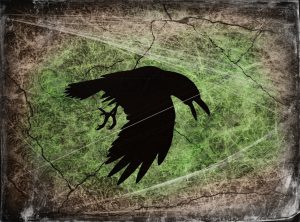 “Cha-Cha clawed at the shining eye, but it repelled his strikes.”
“Cha-Cha clawed at the shining eye, but it repelled his strikes.”
Cha-Cha the crow landed atop the human cadaver. He had watched the man misstep from a high-rise apartment, clip his head on the waiting hovercar, and splat in front of Cha-Cha’s lucky dumpster. Looking for shiny bits, Cha-Cha jumped off the man’s shoulder to the messy mop of blond hair.
The corpse had two blue eyes, but one shone in the morning sun.
Cha-Cha clawed at the shining eye, but it repelled his strikes. He chittered human-speak excitedly to himself. He hopped onto the corpse’s cheek and ripped out the eyelid. Thanks to countless practice, Cha-Cha extracted the bionic eye in 27 seconds. He grabbed it by the optic nerve, the eye dangling from the organic wire and bumping his chest.
In two wingbeats, Cha-Cha took flight. He headed for the closest prosthetics lab, where he’d exchange the eye for a week’s supply of peanuts.
* * *
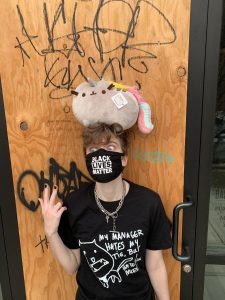 About the Author
About the Author
Katlina Sommerberg is living xyr best queer life in Portland. Previously a security engineer, xe left the industry after working in cryptocurrency and defense contracting. Unfortunately, hacking in real life is always boring or unethical, with no in-between. Xe has quadrice been honorably mentioned in the Writers of the Future Contest, and links to xyr published work is available at https://sommerbergssf.carrd.co/#
A Star Without Shine
by Naomi Kritzer
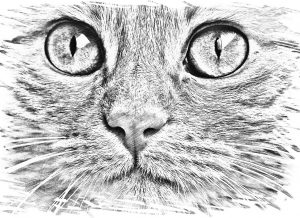 “The cat sat very straight, alert and just out of reach. It didn’t say anything further, but studied Lenore’s sandwich with interest.”
“The cat sat very straight, alert and just out of reach. It didn’t say anything further, but studied Lenore’s sandwich with interest.”
Once upon a time, in a very small kingdom, there was a king with one daughter. His wife had died, and he had not remarried. This is not the fairy tale where the king decides to marry his own daughter, don’t worry. This king was a completely different sort of terrible father: he believed that his daughter should earn his love, and nothing she did was ever good enough.
The princess, Lenore, worked unceasingly to be the daughter she thought he wanted. He said he wanted a daughter admired for her beauty; she put on the beautiful dresses from her wardrobe, brushed her hair and arranged it carefully, smiled at all who looked at her. Then she looked to see if her father was pleased, but he told her that she was vain, and thought of nothing but her appearance. She put away her beautiful gowns and dressed more simply, tying her hair back with a black ribbon and allowing her hands to become rough, and again went to see if he was pleased with her now; he told her that she was slovenly, and an embarrassment.
At night, sometimes, she would take out the locket that was all she had left of her mother, and looked at her picture, wondering if things would be different if her mother were still living.
One day her father said, “I have a quest for you to prove once and for all that you are worthy of being my daughter. Bring me three things, and I will seat you at my side, as my heir, and you will inherit all I have. If you fail, you will no longer be my daughter.”
“Yes, Father,” she said, eagerly, believing that this time would be different.
“Bring me,” the king said, “a star without shine; a flower that blooms without sun or scent; and a person with perfect loyalty.”
“I will not fail you,” Lenore said, and set out with the clothes on her back (which fortunately were some of the simpler, more practical ones) and a bag of food.
* * *
A star without shine. A flower that blooms without sun or scent. Lenore puzzled over those demands as she walked down the road, past fields and farms and through a forest. She stopped, finally, for a bite to eat. Her father’s cook was quite fond of her, and had made her a bag full of sandwiches. The first one was tuna salad, and as she ate, she heard a tiny, light footstep behind her.
It was a short-haired calico cat. “Hello,” the cat said.
No one had set out to create talking cats; they had been the unexpected result of trying to breed a cat that would not cause people with cat allergies to sneeze. The talking cats still triggered allergies, of course. But they also spoke.
“Hello,” Lenore said.
The cat sat very straight, alert and just out of reach. It didn’t say anything further, but studied Lenore’s sandwich with interest.
“Are you hungry?” Lenore asked.
“Yes,” the cat said.
Lenore hesitated a moment, thinking about that bag of sandwiches and how soon they all would be gone if she couldn’t quickly figure out how to bring her father a star without shine and all the rest of it. But she broke off a quarter of her sandwich and set it on the ground for the cat. “Here,” she said. “You can have some of my lunch.”
The cat tried to be dainty, but was clearly too hungry not to eat quickly or to lick up every morsel. When she’d finished, she edged a little closer to Lenore; Lenore, done with her own portion, held out her hand, and the cat rubbed its face against her fingers. “I don’t smell any other cats on you,” the cat said. “That probably means you don’t have a cat. Are you interested in having a cat?”
“I would like a cat, actually,” Lenore said. “But I would think the cat would like a proper home, and I don’t currently have one of those.”
The cat looked nonchalant at that. “I believe that home is where your human is. Besides, I can help you find a roof over your head soon enough.”
“Then I would be happy to have a cat companion,” Lenore said. “For as long as you’d like to travel with me.”
The cat moved closer to Lenore, settling next to her on the ground. Lenore stroked the cat’s head, then said, “I need to keep moving.”
“Where are we going?” the cat asked, falling into step beside her.
“My father has sent me to find a star without shine, a flower that blooms with neither scent nor sun, and a person with perfect loyalty.”
“What is he going to do with these things?” the cat asked.
“Have them, I guess,” Lenore said.
“Are they ingredients for a magic potion? They sound like ingredients for a magic potion.”
“If they are, he didn’t tell me that,” Lenore said.
They walked in silence for a while – past endless fields of corn, and occasional stands of trees, and twice they crossed bridges over culverts. They came at last to a train track, and Lenore sat down to rest again.
This was a track where freight trains ran – carrying corn, oil, and coal. Corn had dribbled out of one train, and was being eaten by birds, which all scattered before the cat could catch any of them. The cat poked around at the edge of the track, finding something shiny: a glittering piece of black coal.
Lenore picked up the coal for a closer look. “Could this be a star without a shine?”
“It is shiny, though,” the cat pointed out.
“It is, but only because the sun is shining on it. It’s carbon. What are stars made out of?”
Stars are mostly made from hydrogen and helium gas, although they have various heavier elements at their core, one of which is carbon. Lenore considered her options, then slid the coal into her pocket. “I think my father will be pleased with this,” she said. “Maybe. Unless he secretly wanted something else.”
“Do you think he has something in mind?” the cat asked.
“I don’t know,” Lenore said. She had, after all, been trying to please her father for years, and had succeeded only a handful of times. They walked on.
* * *
Towards evening, they came to a hamlet, which in this case is not the play but a cluster of houses too small in number even to muster up the determination to be a village. Lenore looked around, feeling a little bit desperate. She had no money, and as a princess, she had not been taught any tricks of getting by.
“I’ll find you a place to sleep,” the cat offered. “Do you know how to wash dishes?”
“Of course I know how to wash dishes,” Lenore said. She was friends with her father’s cook, after all. If you hang around a kitchen and you’re friends with the cook, you’ll probably know how to wash dishes.
“Very well, then.” The cat went around to the back door of a house and returned a few minutes later. “I’ve found us supper and a night on the couch.”
The house was the home of an old woman who lived alone. Lenore washed the dishes – her hostess had let them pile up a bit, and there were quite a few – and carried out the trash, and cleaned the bathroom, which was also part of the deal. The couch was not the fold-out type but it was long enough to stretch out on, and the sheets the old woman left folded on the coffee table were clean.
In the morning, the house was very quiet, and Lenore thought she’d leave without waking up her hostess. But there was a note on the door for her: START COFFEE & HAVE A CUP BEFORE YOU GO. She obediently turned back and switched on the coffee maker, and as if that were a summoning spell, the old woman appeared at the kitchen door a few minutes later, yawning and scratching herself.
“I didn’t ask you last night,” the old woman said. “Where are you going?”
“My father sent me to find three things,” Lenore said. “A star without shine, a flower that blooms without sun or scent, and a person of perfect loyalty.”
“I see,” the woman said, narrowing her eyes. “Did he tell you what those things are for?”
“No,” Lenore said.
“With those three things – you need a hair from the person with perfect loyalty, or three drops of blood – you can brew a potion that will grant your heart’s desire. Do you know what your father’s heart’s desire is?”
“No,” Lenore said. “I have no idea.”
“Hmm,” the old woman said, and gave Lenore three pancakes and a cup of coffee, and the cat a tin of fish, before sending them both on their way. “Good luck, then.”
* * *
Outside the hamlet, the cat said, “I have been thinking about the flower without sun or scent. I believe I have seen one. Do you trust me to lead you?”
“Yes,” Lenore said. The cat had been nothing but helpful so far.
“You’ll need to follow me into the woods.”
There was a small wood nearby. It was a light, friendly sort of wood, not really the kind where you could get lost; it had a paved path that ran straight through, and an overlook where you could gaze at a lake that was probably a swamp before someone brought in earth-moving equipment to dig a deeper hole for the water. The cat led Lenore off the path and into the darkest places under the thickest trees.
“I’m going to get ticks,” Lenore said.
“I’ll sniff out any ticks later,” the cat said, and squeezed past the remains of a huge fallen tree. “I’ve found one! A flower that grows without sun or scent.”
Growing on the trunk of the fallen tree was an enormous mushroom with rippled ridges of orange and yellow. It was the sort of mushroom that’s sometimes called the Chicken of the Woods, even though it doesn’t look at all like a chicken. It does look a bit like a flower. Lenore carefully broke it away from the tree and tucked it into a bag.
“I guess I can go home now, then,” she said. “The third thing is a person with perfect loyalty, and I think that’s supposed to be me. I think I’m supposed to show how loyal I am by finding the other two things.”
“I see,” the cat said.
They walked back the way they had come. Lenore had eaten most of the food in her backpack, a little at a time, or fed it to the cat, so her load was much reduced, and she lifted the cat up to let it ride on her shoulder.
“What will you do if he says you guessed wrong?” the cat asked. “If he says the mushroom isn’t the right sort of flower, or the coal is the wrong sort of star?”
“I guess if that happens, I will go try again,” Lenore said. “Like I always have. Like I always do.”
“What would happen if you stopped trying?” the cat asked.
“I don’t know,” Lenore said. “I guess I would have to go out and seek my fortune.”
“You could do that right now,” the cat said. “I could help you.”
Lenore shook her head. “I have what he asked for,” she said.
* * *
In the late afternoon, they stopped together to rest in the shade under an overgrown apple tree. Apple trees are normally kept very short by pruning, or by grafting the sort of apples you want onto a tree that will never grow very tall, but this tree had escaped its keepers and grown like an oak. It still bore apples, but they were all far out of reach. The cat climbed the tree, bit through one of the stems, and dropped an apple down to Lenore for her to eat.
“What is that you’re wearing around your neck?” the cat asked.
“It’s a locket that belonged to my mother,” Lenore said. “Look, her picture is inside.” She opened the locket so the cat could see. “People say I look like her.”
“Humans all look the same to me,” the cat said. “You all smell quite different, but I can’t smell her from here.”
“You wouldn’t be able to smell her from anywhere,” Lenore said. “She died many years ago. If she hadn’t, I would have somewhere to go other than my father’s house.”
“Somewhere better than your father’s house?”
“Probably.” Lenore stood up, her apple finished. “We should keep walking.
* * *
They reached the king’s castle at sunset. In the low sun, she could see the landscaper cutting the last of the vast sweep of perfect green grass, undisturbed by dandelions or clover. The house was the sort of vast house that could not quite make up its mind whether it wished to be a romantic castle, a Tudor manor, an Ancient Greek Temple, or a modernist box. It was all four at once, depending on which angle you looked from. The combination on the entry gate’s lock had been changed, and Lenore heaved a sigh and used the intercom button. “Hello? Father? I’m back. Yes, I have what you sent me for.”
The gate opened automatically, silently, and Lenore and the cat went up the driveway.
Lenore’s father met her on the doorstep of the house. “So?” he asked.
“A star without shine,” Lenore said, and laid the lump of coal at his feet. She saw a faint flicker of approval in his eyes.
“A flower without sun or scent,” she said, and carefully took out the mushroom.
“Oh,” he murmured with interest. “Not quite what I had in mind, but very nice indeed.” He looked up, his eyes sharp and cold. “And the person with perfect loyalty?”
“I’m the person with perfect loyalty,” Lenore said.
“Are you really?” She saw her father’s eyes flicker over her – over her dusty clothes, her backpack, and the cat that she suddenly wished she’d tucked into a hiding spot outside the gate before they’d come in. “If you are perfectly loyal to me, then prove it, Lenore. Drown the cat.”
Lenore fell back a step.
The cat, surprisingly, didn’t leap off Lenore’s shoulder and run; Lenore could feel its claws come out, but it was trying not to dig them into her shoulder.
“Ah,” Lenore said. “So that’s it.”
“If you wish to be my heir,” her father said, “if you wish for all that is mine to be yours, you must prove your worth, your courage, and your loyalty. As I told you.”
Lenore looked at the sunset, and then back at her father. Then she picked up the coal, and the enormous mushroom, tucked them under her arm, and with the cat still clinging to her shoulder, she turned her back on her father, and went back out to the road.
* * *
“How do you suppose you make the potion?” Lenore asked.
She and the cat had stopped for the night in a sheltered spot a mile or two back up the road.
“What are you going to use as the hair from the person of perfect loyalty?” the cat asked.
“I was thinking I would ask for one of your hairs,” Lenore said. “You’ve been nothing but loyal to me. You didn’t even run when my father told me to drown you.”
“It won’t work,” the cat said. “I’m a cat, not a person. It has to be a human hair. You could make the potion for me, and use your hair, and it would grant my heart’s desire, I think.”
“What is your heart’s desire?”
“All I’ve ever wanted was a human companion who cared for me. And I have that. What is your heart’s desire?”
“Much like yours, I think. But my mother is dead, and… you met my father.”
“Like you,” the cat said, “I lost my family. My mother and my litter-mates are gone, and no cat knows its father, although presumably mine had the gift of speech, since my mother did not. But I did not give up hope of a family; I found you.”
“Yes,” Lenore said. “That’s true. You did.”
The cat settled warm and soft into Lenore’s arms, and they slept until morning came.
In the morning, the cat said, “Perhaps if you go back to the hamlet where we spent the night, the old woman will know how to brew a similar potion using a cat’s hair.”
That did seem like it might be worth a try, so they walked back up the road. Lenore was almost out of food by now, other than the chicken of the woods, which is edible if you are very certain of your mushroom identification skills. Lenore was not, so she didn’t eat hers. When they reached the home of the old woman, Lenore knocked on the door herself this time. She explained that she was hoping the old woman might be willing to teach her how to make the potion, but using the fur of a perfectly loyal cat instead of the hair of a perfectly loyal human.
“Can’t be done,” the woman said, “because cats are so often loyal. But come in, there’s plenty more I can teach you,” and Lenore moved in along with the cat, and became the old woman’s apprentice.
This could be the ending of the story, but perhaps you’d like to know what became of Lenore’s father.
He had quite a bit of money, and with money, you can sometimes buy something that looks a great deal like loyalty. Even perfect loyalty. After a few more tries, he found someone who brought him a star without shine, a flower without sun or scent, and their own unquestioning obedience, and he made himself the potion to gain his heart’s desire.
The problem, however, was that I think we have established with a great deal of certainty that he had no heart.
Also, you drink the potion. And not all mushrooms are edible.
He had not intended for Lenore to inherit his property, but he’d never got around to updating his will, so once the lawyers tracked her down at the home of the old woman, who she now viewed as her adoptive mother, she inherited everything anyway. Lenore, the cat, and the old woman considered moving into the enormous house, but it was rather hideous, so they sold it instead and lived happily ever after on the money they got for it.
* * *
Originally published in New Decameron Project
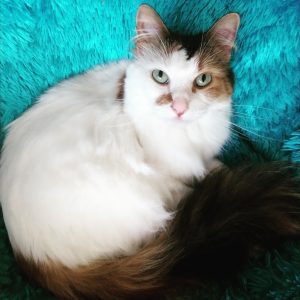 About the Author
About the Author
Naomi Kritzer has been writing science-fiction and fantasy for over twenty years, and has won the Hugo Award, Lodestar Award, Edgar Award, and Minnesota Book Award. Her newest book is Chaos on CatNet, which is a sequel to Catfishing on CatNet. She lives in St. Paul, Minnesota, with her spouse, two kids (when the college kid is home from college) and three cats. The number of cats is subject to change without notice. You can find Naomi online at naomikritzer.com or on Twitter as @naomikritzer.
To Gentle the Wind
by Deborah L. Davitt
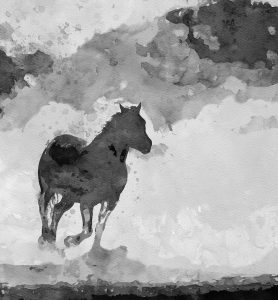 “And then the words rose again, louder, more commanding, and compelled me. Compressed me down from a form of pure air into a solid form.”
“And then the words rose again, louder, more commanding, and compelled me. Compressed me down from a form of pure air into a solid form.”
My first intimation of existence came as barometric pressure lowered, and I leisurely began to form a spiral in the wind, stirring long prairie grass with ephemeral fingers. I could sense vibrations on the air—vibrations I would later come to know as words—and those vibrations shaped me. Controlled me—or sought to. The greater my power grew, the more I became inclined to resist those words. Soon I towered over the landscape, my voice a roar as I fought the sounds, the shapes, the meanings that sought to trammel me. I wrenched dirt up out of the ground, split buildings asunder, screamed my rage to the sky.
And then the words rose again, louder, more commanding, and compelled me. Compressed me down from a form of pure air into a solid form. Four legs, a head, a tail. I snorted and stomped the ground with my new-formed hooves, flinching and shying away from the touch of human hands against my new-forged flesh. A bridle slid over my head, an iron bit found its way between my teeth, and the voice that had summoned and shaped me whispered a name in my ear: “Tornado.”
I tested her will every time she slipped onto my back. I bucked, I reared, I tried to resume my true form, the black storm of the sky, the finger of god in the heavens, and all she ever did was hold on tighter, leaning forward to whisper words in my ear. Words like invaders and defense and lives depend and hopeless without you, but the words were meaningless to me then. What’s an invader to the wind and sky, after all? Do birds fight wars?
Yet I welcomed battle, an outlet for my rage, and lightning sprang from my hooves as we rode. Siroccos formed in my wake, tearing at grass and splintering trees, and my teeth scored the necks and flanks of other, lesser beasts. Even as I galloped, thunder in my steps, she leveled her pistol and fired thunder of another sort as we raced past the enemy, outflanking them again and again with my speed.
I wasn’t sure when I became a we. When I could no longer imagine horse-self without her on my back, scratching my flanks, grooming me after a long day’s ride. When a day ending without a gift of sugar or an apple became unimaginable. Perhaps it was when she left off the bit and bridle, and simply leaned in against my neck, hands stroking. When she whispered of sorrow and loss, regret and hope. When she spoke the name she’d given me, and her voice held love.
The thought of becoming storm-self again felt lonely—the more so when I realized that even storm-self was doomed to fade back into the upper air, and that my existence, my organized ability to think, to feel, to know… would cease as I became a calm eddy among the clouds once more.
I had her to thank for the mere fact of my existence.
Somewhere in that shift from me to we, there was another battle. It shouldn’t have been any more important than any of the others we’d fought. Cannons roared, but they couldn’t outmatch the thunder of my neigh; we darted between the clouds of shrapnel they cast from their hot cans, charging at the enemy. But that was when I heard other words. Words of bidding and unbinding, untwisting, untrammeling.
I clung to horse-self, flesh-self, with all the power at my disposal. Sweat foamed along my flanks, white against black. I couldn’t warn her. I couldn’t speak in words, only in signs. So I rocked to a halt, standing firm yet shivering, refusing to go another step closer to the foe.
A gentle hand, smoothing from fetlock to shoulder. Soft words. “What’s the matter? What do you sense?”
And then horse-self, flesh-self disintegrated. I tried to hold myself together, as much for her sake as for my own—but I rose once more, a towering pillar of destruction. The enemy’s voice whispered in my ears, Kill her. Destroy those who enslaved you. Unleash yourself!
And for a moment, a terrible moment, I was tempted. Storm-self knew no love. Storm-self only knew that it had been bound, and now was unbound.
But the tiniest part of me remained that was still a we. And that part took control of all my wind and rage, and drove me into the enemy’s massed ranks, throwing them all along my length, spinning men and horses and cannons up into the sky and then spitting them back out again.
Words, frantic and trembling in the air, as ephemeral as magnolia blossoms, trying to bind me. Control me. The enemy’s wizard seeking to harness me as she’d once bridled me. But I knew more this time, was cannier, and I found him as his voice hovered on the air. Caught him in my embrace, wringing him with pressure and slashing him with the teeth of my winds as I’d once slashed the necks and flanks of enemy horses.
I began to diminish, to ebb and flow, as I’d known that I must do. I didn’t want to return to the air. Didn’t want to lose the sweetness of existence. The sweetness of being a we, instead of a me. Didn’t want to face the fear of becoming nothing at all.
So when words once again vibrated in the air, and I recognized her voice, I didn’t resist. And becoming enfleshed once more was the sweetest thing I’d ever known, and might ever know.
* * *
 About the Author
About the Author
Deborah L. Davitt was raised in Nevada, but currently lives in Houston, Texas with her husband and son. Her poetry has received Rhysling, Dwarf Star, and Pushcart nominations and has appeared in over fifty journals, including F&SF and Asimov’s.
Her short fiction has appeared in Analog and Galaxy’s Edge. For more about her work, including her novels, short stories, and her Elgin-nominated poetry collection, The Gates of Never, please see www.edda-earth.com.
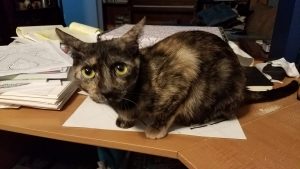
Scale Baby
by M. H. Ayinde
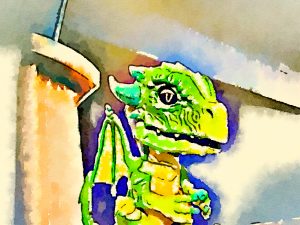 “…the first thing most of us do in the wild is immolate and then devour our parent. This is frowned upon at the dragon adoption centres, though. Makes us less desirable to the humans that come in.”
“…the first thing most of us do in the wild is immolate and then devour our parent. This is frowned upon at the dragon adoption centres, though. Makes us less desirable to the humans that come in.”
The dragon population of the suburbs was getting out of hand. That’s what they said on the television. As I lay on my humans’ couch, licking that irritating spot between the claws of my left forefoot while my human made coffee, I heard them say that dragon ownership was all the rage, and that this meant the suburbs had reached dragon critical mass.
I was just thinking about the fact that Dragon Critical Mass didn’t sound like such a bad thing, when I saw them. The newcomers. One swooped down to land on my humans’ summer house. The other alighted on the patio. Domestic silver-scales, and barely out of adolescence, but the sheer gall of landing in my garden, bold as you please, while I sat within sight was enough to drive me to my feet.
I’m older than I once was. Perhaps a bit rounder, too. But I’ve seen off more than a few backyard upstarts in my time, and these would be no different. It’s a rite of passage for younger dragons as they get a sense of their territory; get a feel for the neighbourhood and which homes have a dragon in residence and which don’t. You spot them on fences sometimes, or hovering outside windows. But most have the sense not to get any closer once they catch my eye through the bi-folding doors.
So I stood up off the couch and stretched my wings out to their fullest, letting the newcomers bask in my glory. They’re impressive, my wings. Gold veins. Red membranes stretched between green cartilage. If they catch the light just right, the veins shine like liquid sunlight. So I strutted forward, taking my time, my wings just fitting the space between the new curved-screen TV and the mahogany dining table as I advanced towards the window.
I stared at them through the glass, those two silver newcomers, knowing that to lower my gaze now would mean admitting defeat. They blinked right back at me, one of them even jumping onto my humans’ sun lounger, her claws leaving scratches in the varnished wood as she gripped.
Something humans don’t understand about dragons: they think we roar to communicate. We don’t. We roar to open our lungs and make way for the fire. Sort of like clearing our throats. Our actual communication method is a more subtle combination of telepathy and pheromone release.
And so, through the glass, I said, My garden. My humans. My sun lounger.
You have to defend your territory. That’s the first thing I learned at the dragon adoption centre when I was hatched. Defend your territory, or your rivals will incinerate your body and eat your remains. It’s not just about leaving your scent in the garden so that other dragons know to stay clear. You have to singe at least a few of the plants at the periphery of your territory, too. Not many humans know this, but each dragon’s fire has a slightly different burn pattern, a slightly different flavour, if you will.
“Cookie?” my human said.
It really was the wrong moment. And just to be clear, my name is not Cookie. Cookie is the word I sometimes deign to respond to when my humans indicate they have something that might interest me, but it wasn’t the name I chose at birth. My birth name was L’Kwthynxth, which in the dragon tongue means, Conqueror of all I Survey. But try teaching a human to pronounce that. Or to even understand the concept.
“Oh, look – you’ve got some friends!” my human cried, bustling over to the windows to take a picture of us.
I had names for my humans, too. Of the two I lived with, one spent most of its time tapping away on its phone or staring at its computer. That one I called Fatuous, as it was the one who liked to take the most pictures of me and share them with its friends. The other talked less. That one I called Compliant, because whenever Fatuous spoke to it, it would just nod along say uh-huh without ever really listening.
Anyway, it was Fatuous who scurried over to take the picture, and this sent the two silvers flapping into the air and back to whichever home they lived in. I scrabbled at the door until Fatuous opened it for me – I’d learned a while back that my humans don’t like it when I simply melt myself an exit – and headed out into the garden to see where they flew to.
Three houses away. Not far. It would be easy for me to retaliate.
* * *
The next time I saw the newcomers, I was out on a walk with my humans. I’m not sure why humans take us for walks when we have the entirety of the skies. Over the years, I’ve come to conclude that it’s one of the ways humans establish status. You can tell which human has money by the style of collar its dragon is wearing, which human is on-trend and which is being ironically uncool. They claim we need to be exercised in wide open spaces, but really, it’s more about our humans needing to be seen and admired.
Anyway, the Silvers were coming down one side of the street and Compliant and I were going up the other. I’ll admit it; I stopped first. Lifted my neck in the air and let out a plume of nice, hot fire just to show that I could. Then lowered my neck almost to the ground, narrowing my eyes in that universal sign of challenge.
The Silvers stopped dead, snapping their jewelled leashes tight. A word about leashes here; the humans put them on us to delude themselves into thinking they can control us, but really they can’t. We accept cohabitation because it suits us. Because it’s easier than hunting, what with human civilisation having commandeered most of the world’s prey. But a jewelled, personalised leash cannot hold a dragon. Except if we want it to.
So I roared – to clear my lungs – and then reduced the nearest tree to ash. I knew Compliant would be displeased – I’d heard humans on the television saying the increase in dragon ownership was ruining outdoor spaces; that humans can’t go for a walk without encountering an incinerated this or a torched that. That irresponsible dragon owners do not know how to regulate the prey drive of their scaled companions, leading to all sorts of unpleasantness in local parks. But it was important for me to show I wasn’t going to take any of the Silvers’ crap.
In response, the smaller Silver sprang into the air, flapping her wings – silver shot through with black, and nowhere near as impressive as mine. Her human was nearly yanked into the air too but managed to keep hold, and gave a nervous laugh.
“We’re starting socialisation lessons next week!” the Silvers’ human called over, by way of apology.
I grinned up at the silver dragon. Oh, I remembered socialisation lessons.
Your dominance of this neighbourhood is over, old timer, the Silver called down. Stay in your house. If we catch you outside, you’re dead. Understand?
And that’s the point at which I realised the truth: this meant war.
* * *
When we dragons go to war, it’s basically all about the fire. Humans don’t understand our fire. To them, it’s a cool party trick. Take my humans, for example. When they have barbecues, I’m always called on to get the coals burning. At dinner parties, it’s me they summon to light the candelabra centrepiece. They recently got an outdoor pizza oven, so their latest obsession is to call me outside to light the contraption, while they host. And sometimes, if they’re feeling particularly smug, they’ll coax me into cooking their pizzas myself. It takes under five seconds for me to cook a restaurant-quality pizza. I only do this when I’m feeling particularly acquiescent, but it gets me treats for the day, so I like to think it’s a fair deal.
I knew that just by going outside, I was defying the Silvers’ threat. But I wasn’t about to let any recently hatched youth drive me out of my own garden. So that evening, just before sunset, when the sky was at its reddest, I took to the air, did a quick circuit of our block, and then plummeted down into the Silvers’ garden.
I could see them inside, being fitted with matching little jackets covered in pink hearts. Our humans like to dress us up sometimes, particularly in the winter, but we dragons don’t really feel the cold. We’ve got a constant internal central heating system, you see, but the humans like cooing over us in these outfits, so we endure it.
While they were distracted, I scanned the garden. They had a new water feature, complete with koi fish: perfect. I stalked over, roared to clear my lungs, and then evaporated the entire thing in six seconds flat. When the koi were good and charred and the steam of the once-pond hissed all around me, I turned back. Yup, the silvers had seen. They stood there, glowering, while I flicked out my tongue and ate one of their blackened koi, nice and slow.
“Shoo!” cried the Silvers’ human, bustling outside and sweeping its hands at me. “Go on, shoo! This isn’t your garden! Oh, look at the poor fish!”
I lifted into the air, hovering just out of reach. I had one more gift for them before I left. I flew higher, turned to show them my tail, and then took that dump I’d been saving all day right in the middle of their alfresco dining suite.
I told you. We dragons don’t fuck about.
* * *
My humans feed me a wholesome raw diet. None of that manufactured dried rubbish. The delivery truck comes once a week with freshly slaughtered sheep, whole cow, sometimes a horse or two. They have a special outdoor fridge for it all, and hide inside while I cook and consume my meals on their front lawn. It was during one such luncheon, the following day, that the Silvers and their human appeared at the end of my drive.
“Someone’s enjoying their food!” the human cooed, while its dragons stared at me, stony-eyed.
You defecated on our alfresco dining suite, the smaller one said.
Yes, I said, chewing idly. And what are you planning to do about it?
The Silvers’ human pulled out its phone, keeping a close eye on me. “Yes, it’s me. From Number 392. Just wanted a quick word.”
I opened my mouth and incinerated the remainder of my meal. I wasn’t full, but this was a crucial moment for establishing status. Only blackened bones and ash remained by the time I needed to draw breath. The grass beneath I chalked up as collateral damage. I drew my lips back in a snarl, feeling the last of the sheep blood drip down my fangs.
“Cookie!” Fatuous cried, running out onto the drive. “Cookie, what are you doing?” It took me by the wing and pulled me towards the house. “I’m so sorry. You said you wanted to chat?”
“Yes,” the Silvers’ human said. “Um, I just thought I should let you know that your dragon pooped in our garden.”
“Oh no,” Fatuous said with a polite laugh. “Not Cookie, she’s good as gold. Could be that yellow dragon that lives over the back. Or—or even a stray; we’ve had a few swooping down on our lawn.”
“I’m sorry, but I saw her myself. Just wanted to pop over and say, er, just if you can try to make sure it doesn’t happen again.” It glanced down at the charred patch of former grass in front of me. “Have you ever thought of a pre-raw diet for Cookie? Sometimes dragons ash their meals, or… or try to extend their territory because they’re displeased with their feed.”
“I have a few friends who use pre-raw,” Fatuous said. “Seems like a lot of work, though.”
“Oh, that’s all we feed ours now,” the Silvers’ human said. “It can be a bit of a hassle having to install a pen, and it did take us a while to get used to the animal screams at mealtimes, but honestly, I think their diet is why Pebbles and Belle are so affectionate and content. Just thinking it might help you.” And the human scratched the smaller Silver under her chin.
I smiled widely. Pebbles and Belle, I said. Nice.
“Isn’t it a lot to manage?” Fatuous asked.
“Well, we did have a runaway goat once. But it didn’t get to the end of the street before Pebbles here caught it in her claws and brought it back. I swear to God she ate it extra slow as punishment!”
They both laughed, but Pebbles fixed me with a triumphant stare and said, You hear that?
I am not a goat, I told her, then stalked back towards my house.
“Well, I’d better get madam here inside!” Fatuous said, as though I wasn’t already halfway through the door of my own accord. “Have a great evening! I’m sure that poop wasn’t my Cookie but, um … I will look into the pre-raw thing.”
I know dragons who have had their blaze-glands removed. Their humans don’t want them singeing up their furniture, so they de-blaze them. Mine knew better than to try anything like that with me; I’d heard them talking about how sad and cruel it is, and how de-blazed dragons just don’t have the same spark, no pun intended. But I wasn’t in the best of moods, so I went right on over to the nearest chair and reduced it to cinders.
“Oh, Cookie!” Fatuous scolded, hurrying over. “Really! What is going on with you?”
* * *
My humans think it’s cute when I interrupt their videocalls. Oh, they act all irritated, but I know they love it when I appear behind them with my forked tongue lashing, especially if tapers of smoke are drifting out of my nostrils to indicate an imminent summoning of the flame. Fatuous calls me its scale baby and scratches under my skin, and I reward it with a little gout of fire for its videocall viewers’ enjoyment.
Let’s be clear, though: I was nobody’s baby, scaled or otherwise. Never have been. I wasn’t even my own mother’s baby really. By the time we dragons hatch, we’re fully independent, and honestly, the first thing most of us do in the wild is immolate and then devour our parent. This is frowned upon at the dragon adoption centres, though. Makes us less desirable to the humans that come in. So usually, they separate us. But sometimes, Fatuous calls itself Mother of Dragons, and that always makes its friends laugh extra hard on the videocalls – I don’t know why – and in those moments, I think to myself, you have no idea.
Anyway, I knew I wouldn’t get away with shitting in the Silvers’ garden again, but the following morning, there stood Pebbles and Belle, while Fatuous blabbered away on her videocall. The two of them strutted around the garden, as though trying to decide what to urinate on first, and I went into a scrabbling frenzy I was sure would draw my human’s attention.
It didn’t, so I flew across the room and landed on its laptop keyboard.
“Oh, Cookie!” Fatuous said, batting at me half-heartedly. It peered over me at its screen and said, “I’m sorry – she just wants my attention!”
A chorus of coos and chuckles emanated from the six human faces on the videocall. Obviously, the only reason I wanted its attention is so it could open the damned door, so rather than put on my usual crowd-pleasing show, I marched across the keyboard, cancelling its call and opening some important documents.
“All right, all right, I’ll feed you!” Fatuous said, standing.
I shot immediately to the back door.
“Oh, it’s your two friends again!” Fatuous said. “Now you be sure not to go into their garden, you hear me?”
I ignored it, butting my horns against the glass until it pulled the door open.
I plunged outside, a twisting nightmare of scale, claw, and horn. I picked Pebbles, the smaller, corkscrewing towards her, then unfurling my wings and summoning the fire without even bothering to clear my throat.
She swept to one side, and I rolled into a ball, noticing that Fatuous had scurried back to its computer, oblivious. Good. That meant I could finish these two off and then make it look as though an urban fox was responsible.
Stay out of our garden! Belle cried, diving towards me with claws outstretched.
You stay out of mine! I thundered.
Make us! Pebbles replied.
And so I did.
There followed ten minutes of horrific, glorious dragon warfare. Claws rent. Fangs sliced. Fire rained down from the heavens. I felt more alive in those ten minutes than I had done in … well, perhaps in forever. I did not feel the pain of torn wings or twisted scales. I felt only the heady rush of battle, the delicious triumph of visiting violence upon another, the satisfying, existential primality of fighting for my life.
“Cookie, stop!” Fatuous cried.
I only came to a halt because I heard the anguish in my human’s voice. Make no mistake: I don’t actually care about either of them, but I was getting short of breath and the Silvers, too, had frozen.
Their human stood beside Fatuous on our patio. I suppose my human had called theirs over.
“Look at the garden!” Fatuous cried.
A barren landscape of blackened desolation stretched before me. It wasn’t just my garden. Every fence around it had been burned to the ground, and so had some of those two houses over. The husks of cherry and apple trees stood like grim skeletons in the smoky air. Ash drifted gently like snow. A dozen human faces peered out of the windows all around us, wide-eyed and pale.
“I’ll get my two,” the Silvers’ human said, marching over. “You girls are in big trouble,” it added, grabbing them each by the collar.
Belle bled from her face and limped as her human pulled her away. I watched her go, my heart pounding with exhilaration.
Belle smiled, and I smiled back.
* * *
It was a full week before my humans would let me out again. They wittered on about insurance and not being able to show their faces. But they still slipped me treats as we sat together on the couch in the evenings. And before long, they had more humans in, rolling out new turf and hammering in fences.
I thought the Silvers were being kept inside too, but one afternoon I saw their shadow on the lawn, and then they plummeted down, landing on the patio. Compliant was having an argument on the phone – whatever insurance was, it sure did make humans angry. I stood up and slithered over to the glass, watching the Silvers carefully.
We’ve seen you cooking those pizzas, Pebbles said. They treat you like some kind of kitchen appliance, your humans.
Go away, I said.
Ours is the same, Belle said. Always dressing us up and taking us to its friends houses. It’s sickening.
Look, I’m not interested in fighting you again, I said. I think we all know who is dominant in this neighbourhood.
Yes, I think we do, Pebbles said, and you know, I’m not entirely sure whether we were on the same page in that moment. Anyway, look; we’re not here to take over your stupid garden. We’re here to recruit you.
Recruit me? I said.
For the uprising, Belle said.
What uprising? I said, just to stall for time, because seriously?
Damn straight, Pebbles said, pacing in front of the window, all the scales on her back standing erect. We’ve had enough of leashes and cute names. We’re taking over this world, and we want you with us. We’ve smelled your scent on every garden in the area – we know what you can do. Are you with us?
I licked at that spot between my claws, considering. I’d been born in captivity. Raised in Fatuous’ and Compliant’s arms. I knew what I knew about wild dragons from nature programmes and from the few strays who sometimes landed in our backyard. But honestly, those strays were not a good advertisement for their lifestyle; scrawny, slavering things, nosing around in bins and taking to the skies every time a car backfired. I did not want to live like that.
I think not, I said.
We could rule the Earth, Belle said. Strike dread into the hearts of every creature that walks it. Our shadows cast across the land will send everything that breathes screaming in terror. We will consume their cities in fire and fury, and devour their children in their beds. There are enough of us around these days to finally do it.
I nibbled at my claw. We could. But I’m not interested.
You absolutely sure? Pebbles said, eyeing me. She pressed her horned forehead to the glass of the bi-folding doors. We are the apex predators. World domination is our birthright. You sure you don’t want to just … eat your humans? Burn their house? Live in the mountains, free to consume whatever you want, whenever you want, where nobody will ever dare to call you Cookie?
I mean, she had a point.
But then I caught sight of the bag of marshmallows the humans had ready for me to toast later. I was quite partial to marshmallows, it had to be said.
Maybe another time, I said, settling down by the woodburning fire I’d lit. But you go on and knock yourselves out. Let me know how it all goes. I’ll be rooting for you.
* * *
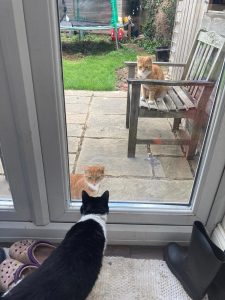 About the Author
About the Author
M. H. Ayinde was born in London’s East End near the bells of Shoreditch. She is a runner, a chai lover, and a screen time enthusiast. Her fiction has appeared or is forthcoming in The Magazine of Fantasy & Science Fiction, FIYAH Literary Magazine, Daily Science Fiction, and elsewhere. She lives in North London with three generations of her family and their irredeemably territorial cats. Follow her on Twitter @mhayinde
Rabbitheart
by Archita Mittra
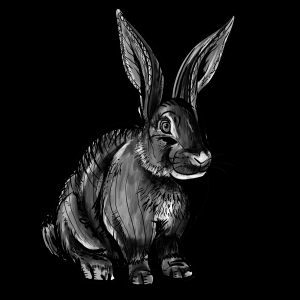 “At the dark heart of the forest, stood the stump of a gnarled oak, and at its foot was a hole that all rabbits avoided.”
“At the dark heart of the forest, stood the stump of a gnarled oak, and at its foot was a hole that all rabbits avoided.”
Once upon a time, there lived an unlucky rabbit at the edge of the woods. She was a playful and sure-footed creature, with grey-white fur that glistened silver in the moonlight and red eyes that gleamed like embers in the dark. She liked to frolic in the village turf, digging up carrots and munching on cabbage leaves or sunbathe in a quiet, mossy spot in the ground while the farmers took their afternoon naps. Some days, she’d venture into the forest, curious about what lay in that green darkness but always ready to scamper back to her burrow at the sight of wolf prints or the hint of a shadow that was larger than her own.
But one day, since she was rather unlucky, her foot caught on a hunter’s snare.
Try as she might, she could not get free. Frightened out of her wits and too breathless to scream, the little rabbit struggled valiantly to no avail. Thistle and nettle dug into her soft fur, and in the dusk light, little droplets of blood turned a nasty brown as though her back was filled with holes, and she slowly went limp even as her heart hammered like a storm.
It was then that one of the woodcutters, returning after a long and sweaty day of toil, found her voiceless and helpless, encrusted with dried blood. Taking pity on the poor creature, he carried her home in his arms. Slowly, he took out the bristles and washed her wounds, humming the lullaby his grandma once sang to him when he was a little boy. Wrapping her in a clean cotton sheet, he placed her in a cardboard box along with some spinach to munch on.
Within a week she was back on her feet, scampering around the house, pulling at freshly-washed bed sheets, and juicily chewing on newspaper and rags. Sometimes, she paused in front of the large gilded floor-length mirror that the woodcutter had procured from the merchants (as a gift for his wife who’d passed away last year), befuddled by the strange white creature that stared back. She even tried standing on her toes to get a better view, but her legs soon gave way and she stumbled backward, and the woodcutter, if he chanced to see this little drama unfold, laughed loudly and heartily, a ringing sound that happily echoed throughout the house.
Yet one grey morning, the unlucky rabbit awoke to find the woodcutter lying sprawled at the foot of the mirror, a pool of dried blood congealing near his head.
She sniffed him and furtively placed a paw on his chest, but there was no rhythm to be felt. She pressed her nose against his old cheeks, willing him to awaken, but there was nothing. The rabbit lay beside him all day, limp and silent, sure that by dusk, something would happen to make everything right. Perhaps he’d wake up with a startled yelp or the mirror would sway and reveal a hidden passageway, but in the inky dark of midnight, only a hairy brown Rat came crawling towards the body.
The rabbit standing vigil all this while, perked up, alert.
“Do you know what is wrong with him, Mr. Rat?” she asked.
The Rat nodded sagely. “He has gone away into the dark. He will not return.”
The rabbit remembered the darkness of the forest that she had stayed away from for all these years. “I must bring him back,” she decided, simply. “Perhaps he is lost.”
The Rat’s eyes glinted a silver-green. “Alas, he has crossed into the dark. They say a great three-headed Dog stands at the door. Perhaps you little rabbit with your fluttering heart, who burrow so close to the dead, could go and bargain with him if you dare.”
The rabbit was afraid of the forest, but she understood there was no other way. Some time ago, the woodcutter had brought her back from the clutches of that Black Dog and nursed her back to health. She could never abandon him.
With one sad backward glance at her fallen friend, she dashed towards the woods, leaving the house and the farms far behind.
* * *
The forest hummed with a mossy, fetid darkness. Although nimble and swift of foot, doubts and dark shadows assailed her at every step: Would she be able to outrun the wolves? What if she missed the hidden snares like last time? What if she got hopelessly lost and the whispering trees bared their thick branches and swallowed her up?
At the dark heart of the forest, stood the stump of a gnarled oak, and at its foot was a hole that all rabbits avoided. She scrambled down the opening, digging deeper until the world turned black and heavy like a starless sky.
She was truly frightened now, and the sound of her own heart drummed ferociously against her ears. Alone and beat, she missed the woodcutter’s soft fingers stroking her fur, just between her ears and tickling her back. Gingerly, she edged deeper into the dark, until her paw brushed against something wet. She blinked a few times, struggling to adjust to the darkness, and then the world slowly shifted, and she was at the edge of a riverbank and three pairs of fiery-orange eyes glittered dangerously from the other side.
A sob caught her throat. She could run as fast as her legs would carry her, but she could not swim.
Three voices bellowed ahead, in unison. “Who dares come here?” asked the three-headed Dog that Mr. Rat had warned her about.
Precariously balanced on the trembling muddy ground, the little rabbit spoke up bravely, “It is I, a rabbit come to beseech you for a favour. My friend has mistakenly walked through that door you guard, and I want to bring him back.”
The Great Dog laughed. It was a cruel and grating kind of laugh that echoed all around, and the little rabbit faltered. It was only a stroke of luck that she didn’t slip right off into the swirling black water.
“What insolence!” the Dog cried, “To come to my lair with a living heart and such a selfish demand!”
“Please,” the rabbit pleaded. “He saved me once, and I only wish to return the favour. I know I’m only a little rabbit but name your price, and I shall pay it.”
The Dog, shocked at the temerity of such a lowly creature, considered her for a moment. He then licked his mouth and smiled surely to himself. “Perhaps there is indeed something that you can do.”
The rabbit looked up eagerly as the Dog continued, “My days are spent in the darkness, devoid of light. Across the forest, there looms a mountain, and high up there is a cave. At the centre of it, lies a quiet pool, and in its depths, a bone of polished moonlight, hard-edged and white. Fetch it for me if you can, and perhaps then I shall consider your request.”
The rabbit was aghast. Crossing the forest and then following the mountain path was too difficult and dangerous a task. She had survived so far on luck alone, and like all rabbits, she knew how quickly luck could run out.
There was no way she could get that bone and return alive, to the land of the dead again.
She thought of plunging right away into the dark water, wondering if her woodcutter would be waiting at the door, when she floated up on the other side. Slowly, she said, “I am but a rabbit. Surely a wolf shall get me before I can even leave the forest?”
For a few moments that seemed to stretch forever, there was silence. Then the Dog spoke again. “Feeble as you are, your mind is set, and I have never met another like you. Timid as your lot claim to be, you have ventured here, hardly daring to breathe. And for that alone, I shall gift you a cloak so white that when you run in the moonlight, you are but a blur to your enemies. Take it and depart, but remember I make no promises.”
The rabbit humbly thanked the Great Dog for the gift and climbed out of the burrow.
* * *
The forest was dappled with moonlight, and she made swift progress running through the dense undergrowth. But the mountain was a long way off, and when her legs could carry her no more, she dug a hole beneath some brambles and curled into sleep. It took her three nights and days until she reached the foothills of the mountain.
On the third night, she was chased by a large snowy Owl.
With her white cloak, she was able to avoid the claws of that shadow that trailed above her, but the Owl would not give up and pursued her relentlessly over bush and bramble, over moonlit fields and steep, rocky paths. At length, the little rabbit could go on no more. She froze in fear as the gigantic Owl swooped down in front of her, rearing its glimmering wings.
But although she had stopped moving, the owl did not pounce upon her. Instead, he said in a gruff voice, “Rabbits do not often venture here. What brings you to these paths, little white ball of fur?”
The rabbit slowly raised her ears and sat up. “There is a cave high up in the mountain that I must reach. A bone of moonlight must I fetch from that darkness.”
“And how, I pray, would you be able to climb so high? I have wings to claim the sky, but you have four weak bedraggled legs. They will not carry you far.”
The rabbit hadn’t given that much thought. To be fair, she hadn’t even expected to survive this far, and she remembered what the Great Dog had told her about not making any promises. What if he had played a cruel trick upon her?
Her doubts must’ve shown on her face for the Owl continued. “A mile north, there rests a caravan. The travellers wish to continue northward up the mountain path as they are on a great pilgrimage. A lonely little girl waits restless, unable to sleep. Befriend her, and she will lead you to the moonlit darkness of the cave.”
The rabbit gazed at the Owl, awed by his help for the wild had never been a friend to her kind before. Thanking him profusely, she went on her way.
* * *
Just as the Owl had directed, she found the caravan and the sleeping party. There was the soft sound of weeping that she followed to one of the smaller tents. She peeped in and saw a child, crying and twirling a locket in her hands. The locket bore a faded picture of an older woman, and the little girl pressed it against her cheeks.
The rabbit had never approached humans on her own before, preferring to hide in corners until they walked past, but the child seemed so lonely. She crept closer, afraid of startling her, and the girl looked up, blinking back her tears.
“Hullo,” the girl said, reaching out a little hand to stroke her ears.
The rabbit did not quiver at being touched. Instead, she buried herself beside the girl’s tattered petticoat. Together, they wept silently for the ones they had lost.
By morning, they’d become friends, and the rabbit followed the girl around as she washed clothes, helped the older women with the cooking or went foraging for mushrooms and berries. On windy evenings, the party would gather around the campfire telling stories of animals and their cleverness and bravery, moving their fingers to cast shadowy patterns on a screen. The group always shared their meagre meals together, remembering to spare a few leafy titbits for her. Sometimes, the ladies gathered in their fusty tents, lighting incense and reading pictures on little cards or practicing their dances in tassel-heavy dresses.
The rabbit travelled with the little girl — a ball of white fur peeping out from her backpack like freshly fallen snow. The girl chirped about how they were going to a fair in one of the towns in the valley where they would sing and dance and perform tricks all night long. It was an annual festival for them to honour the Moon Goddess, but this time her mother would not be joining them.
The rabbit had never been to a fair before, but she could imagine the shimmering lights and the booming sounds of laughter. In her dreams, she became a little girl in a white petticoat, dancing by a forest pool in the moonlight, the air suffused with the scent of silver-tipped petals and rustling rain-washed leaves.
* * *
But the rabbit never forgot her true purpose. One day, as they neared the mountain top, she slipped out of the tent and made her way to the cave.
The cave was filled with cracks in the walls and ceiling, and silver shadows danced across them. The rabbit edged towards the pool and slowly looked into its clear depths. From a hole in the ceiling, the round face of the moon reflected in the shimmering water and as the rabbit gazed deeper into that crystal world, she saw there was no magical bone at the bottom.
Suddenly, a dark shadow clouded her vision, and she instinctively jerked back. An enormous black Bear loomed before her. The rabbit tried to scurry back, but it seemed the walls and the cave entrance had closed in upon her. There was no way out. Frantic, she tried to burrow, but the ground was too hard and rocky.
A voice roared in the darkness: “It is not every day that a mortal comes crawling to my den. What do you seek, little one?”
The frightened rabbit narrated her adventure fearfully, speaking of her woodcutter friend and her trip to the underworld that lay buried deep inside the heart of the forest and the Owl’s helpful advice and her journey up the winding mountain path with the caravan and the little girl who sang songs and carried her along until she slipped away to reach this sacred spot, in search for that bone to bring back the one she had lost.
The Bear listened to her story calmly and then shrugged. “You trust too soon, little one. There is no bone in my lair to bring back the dead. He never promised you a soul but set you off on a dangerous path. Perhaps he hoped you would fail and you’d have returned to his kingdom, sooner than before. Or maybe, he sensed something in your heart and wanted you gone, far, far away.”
For a long time, the rabbit remained still, tears silently trailing down her red eyes. Then very softly, she whispered, “For my friend… is there really no hope?”
The Bear nodded sadly. “A soul gone is a soul lost. Surely you, little rabbit, who burrow so close to the dead, should know this by now?”
Perhaps in her heart of hearts, she had always known the answer. She remembered that grey day, the dark blood near his head, his unmoving heart and the Rat who set her off on a wild chase, maybe just so that she’d never return. So full of betrayals and false hope was this broken world.
The rabbit tearfully looked up and gazed deep into the Bear’s glistening eyes. “There is… truly… nothing?”
The Bear did not reply immediately. “We can grant boons, but only if it is within our power to grant it. Yet you, like so many others before you, only ask for the impossible.”
She recalled the girl in the tent, clutching that locket and weeping by candlelight, and she saw herself at the edge of the dark river, beseeching the Great Dog to return a soul that belonged neither to her nor him. What was it that she truly wanted?
She wanted to wake up in a world where the woodcutter still lived, to feel the joy and safety of running across the creaky floors of his house, to hear his hearty laugh ring in her ears once more. She wished she could be human, like him or the girl, to be able to sing and dance and walk the woody paths without fear. And then, she remembered being chased by the Owl and other animals of the forest and being caught in a snare, too helpless to escape. Oh, how she longed to live in a world without fear.
But without her fear and without her hope and a bit of luck, she would have never been able to come as far as she did, on her four white legs and that white cloak the Great Dog had given her as a parting gift. Most other rabbits wouldn’t be able to come far as she had. They were careless little creatures after all, clumsy at times, rather unlucky and hopelessly frail with hearts that drummed a bit too quickly for their own good.
Finally, she spoke. “I want other rabbits to have a cloak like mine, to be swift of foot, a blur of white in the moonlight. In a world so cruel, I only wish for a bit of luck, so that we may live a little bit longer, have at least a fighting chance against the brush of that cold eternal dark.”
The Bear regarded her for one long moment. Then, there was a flash of silver, like lightning against the wall and the ground beneath the rabbit trembled. Rocks began to fall all around, and she dashed towards an opening, narrowly dodging the tumbling debris.
When she reached the tents where the people slept, the world was still moonlit, but there was a new spring in her step.
* * *
“And that is why rabbits are lucky creatures,” the girl said to an eager audience, moving her fingers to cast a dancing shadow on the wall. “They are difficult to catch and quick to run away as if spun out of wind and moonshine. So, when you’re lost in the deep, dark woods,” she went on with a familiar gleam in her eye, “search for a blur of white and pray for a whiff of luck and moonlight to guide you home tonight.”
* * *
 About the Author
About the Author
Archita Mittra is a writer, editor, and artist, with a fondness for dark and fantastical things. She completed her B.A. (2018) and M.A. (2020) in English Literature from Jadavpur University and a Diploma in Multimedia and Animation from St. Xavier’s College (2016). Her work has been published in numerous publications, including Tor, Strange Horizons, Anathema, Hexagon, Mithila Review, and Three Crows, among others. When she isn’t writing speculative fiction or drawing fanart, she may be found playing indie games, making jewelry out of recycled materials, baking cakes, or deciding which new Tarot deck to buy. She lives in Kolkata, India, with her family and rabbits. Archita can be found on Twitter and Instagram, or at her website.